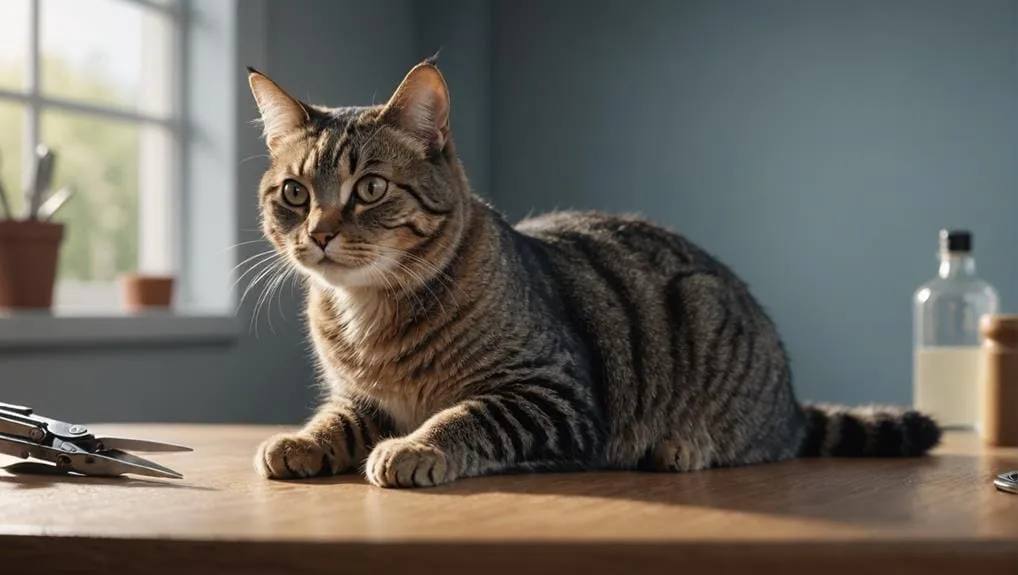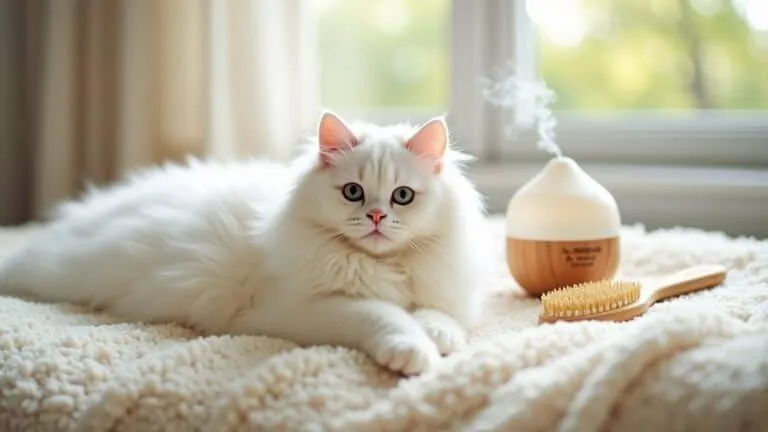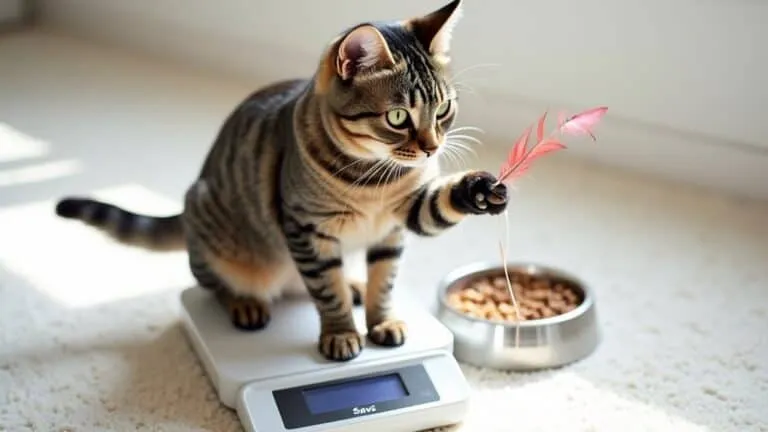The Best Fluffy Pancakes recipe you will fall in love with. Full of tips and tricks to help you make the best pancakes.

Trimming your cat's nails is a must to prevent discomfort, joint issues, and furniture damage. For indoor cats, aim to do this every 1-2 weeks. Keep an eye out for signs that it's time for a trim, like when they can't retract their nails, they're extremely sharp, or curled nails are causing injuries.
To make the process as stress-free as possible, gather what you need: sharp nail trimmers, styptic powder, and some high-value treats. Create a calm environment with soothing music and gentle holding. This will help your cat relax.
Now, it's time to learn the best trimming techniques. Reward your cat for staying calm, and avoid common mistakes. With practice, you'll get the hang of it, and your cat will thank you.
By mastering cat nail trimming, you're taking the first step towards a more comfortable, healthy life for your feline friend.
Trimming Frequency and Consequences
Determining the ideal trimming frequency for your cat's nails is crucial because it directly affects their comfort, behavior, and overall well-being. When you're an indoor cat owner, you'll need to trim your cat's nails every 1-2 weeks to prevent overgrowth.
If you're unsure when to trim, look for signs like the inability to fully retract their nails, extreme sharpness, or potential injuries caused by curled nails. Overgrown nails can lead to discomfort, joint issues from altered gait, and even get stuck in carpets or collars.
Regular nail trimming prevents these consequences and helps maintain your cat's comfort. It also reduces the risk of damage to your furniture and minimizes the risk of scratches and injuries to you during playtime.
By trimming your cat's nails regularly, you're ensuring they can move around comfortably and maintain their overall well-being.
Essential Supplies and Preparation
To trim your cat's nails successfully, you'll need a few essential tools.
You'll need sharp nail trimmers or a grinder. It's also a good idea to have some treats on hand. These will come in handy when rewarding your cat's good behavior.
Creating a calm environment is crucial.
You want your cat to feel as relaxed as possible. This will help minimize stress and make the nail trimming process much smoother. By being prepared and taking steps to reduce anxiety, you'll be well on your way to a successful nail trimming session.
Necessary Tools
You'll need a few essential tools before you start trimming your cat's nails. This will help ensure a safe and stress-free experience for both you and your cat.
First, you'll need a sharp nail trimmer or grinder. This is vital for avoiding pain or injury to your cat's nails during the process.
Next, make sure you have some styptic powder, cornstarch, or flour on hand. These can help you quickly manage any accidental quick cuts that may occur during trimming.
High-value cat treats are also a good idea. These can be used as rewards to motivate your cat and create a positive association with the nail trimming process.
A towel can be useful too. You can wrap your cat in it, providing a sense of security and minimizing movement during the trimming session.
It's also a good idea to enlist a helper to assist with gentle holding. This can make the experience smoother and less stressful for both you and your cat.
With these necessary tools, you'll be well-prepared to trim your cat's nails safely and efficiently. By having everything you need within reach, you can focus on creating a calm and comfortable experience for your cat – even having them sit comfortably in your lap.
Tranquil Environment Creation
So, you want to create a tranquil environment for nail trimming sessions with your cat. Start by choosing a quiet, distraction-free room. This helps minimize stress and sets the tone for a successful, stress-free experience.
To take it a step further, consider using some calming tools. Soothing music can really help. You can also try using calming products like pheromone sprays, such as Feliway, before and during the trimming process.
Make sure you have everything you need within reach. This includes a nail trimmer or grinder, some cat treats for rewards, and styptic powder just in case. You don't want to have to interrupt the process to grab something.
Wrapping your cat in a towel can provide a sense of security and control while you're handling their paws for trimming. Try to make sure no other pets are around, and keep your own demeanor calm to ease your cat's anxiety.
Rewarding Calm Behavior
Calming your cat's nerves during nail trimming sessions requires strategic preparation. To start, you'll need some essential supplies that promote relaxation and reward calm behavior. Having the right tools can make all the difference in creating a positive experience for your cat.
So, what are these must-have tools? Let's take a look.
High-value treats, like Churu, are a great motivator. They reassure your cat and build a positive association with the nail trimming process, encouraging cooperative behavior. Calming pheromone sprays, such as Feliway, reduce anxiety and create a relaxed atmosphere, minimizing stress. And don't underestimate the power of praise and verbal affirmations. They reinforce calm behavior, enhancing the overall experience and fostering trust between you and your cat.
Here's a summary of these tools and their effects:
| Tool | Purpose | Effect |
|---|---|---|
| High-value treats (e.g., Churu) | Motivate and reassure | Builds positive association, encourages cooperative behavior |
| Calming pheromone sprays (e.g., Feliway) | Reduce anxiety | Creates a relaxed atmosphere, minimizes stress |
| Praise and verbal affirmations | Reinforce calm behavior | Enhances overall experience, fosters trust |
Effective Trimming and Restraint Techniques
When you're getting ready to trim your cat's nails, mastering effective trimming and restraint techniques is key.
You need to learn trimming steps that prioritize safety and precision, as well as gentle restraint methods that minimize stress and movement.
The goal is to create a calm and secure environment for the trimming process.
To do this, you'll want to familiarize yourself with comfortable holding techniques.
This way, you can ensure your cat feels safe and secure, making the whole experience much less stressful for both of you.
Trimming Steps Overview
So you want to trim your cat's nails without stressing them out, right?
First, pick a quiet and comfy spot where your cat will feel safe. Gather all the supplies you need beforehand, so you're not scrambling around while trying to trim their nails. This way, you can focus on the task at hand.
When you're ready, gently hold your cat's paw and apply a bit of pressure to extend the nail. Trim just a little at a time, cutting at a 45-degree angle to avoid cutting the quick. Take breaks whenever your cat seems stressed or restless. If they're really fidgety, consider having someone help you hold them steady.
It's super important to trim one paw at a time, starting with the front paws. This helps prevent overwhelming your cat and reduces the risk of accidental cuts.
Gentle Restraint Methods
To keep your cat safe and calm during nail trimming, you need to learn how to hold them securely without causing stress or discomfort. One way to do this is to gently hold their body with one arm, supporting their chest. This will keep them secure and comfortable while you trim their nails.
Having someone to help you can also be a big plus, as they can help stabilize your cat's body and prevent any sudden movements. This makes the trimming process safer for both you and your cat.
It's really important not to scruff your cat, as this can cause them a lot of stress and make them less cooperative in the future. Instead, try using a padded ironing board or something similar that provides a stable surface and prevents slipping.
Remember to use minimal force when restraining your cat, as too much pressure can make them even more stressed and aggressive. By being gentle, you can create a calm and comfortable environment that helps your cat feel safe and cooperative.
Comfortable Holding Techniques
Mastering comfortable holding techniques is key to trimming your cat's nails without stressing them out – and you, too! You want to hold them securely yet gently, so they feel calm and relaxed.
To achieve this, try these tips:
Cradle your cat in your lap or against your body, so they feel supported and secure. This way, they'll be more likely to relax and trust you.
Avoid scruffing your cat, as it can increase their anxiety and make them distrust you. Instead, hold them around the chest or use a towel to secure them, which is much more comfortable for them.
Having a second person to help can make the process even smoother. They can gently hold the cat's body while you focus on trimming, creating a more relaxed atmosphere.
Use a padded surface, like an ironing board, to elevate your cat's paws. This makes it easier and more comfortable for them during the trimming process.
Remember to keep an eye on your cat's body language for signs of stress, such as growling or stiffening. If you notice any of these signs, be prepared to take a break to ensure your cat stays calm and cooperative throughout the session.
Handling Accidental Quick Cuts and Stress
Accidental cuts to the quick can be really stressful, but staying calm and taking swift action is key to minimizing the damage and reducing your cat's stress levels.
If you do accidentally cut the quick, it's essential to have styptic powder on hand to stop the bleeding quickly. Remember to remain calm, because your cat will pick up on your energy and respond accordingly.
If you notice signs of stress, such as tail twitching or body stiffening, take a break and let your cat calm down. Keep a close eye on your cat's body language – sometimes purring can indicate discomfort rather than contentment.
By staying calm and patient, you can build trust and cooperation with your cat, making future trimming sessions more manageable. Your cat's well-being is the top priority, so always put their comfort and safety above everything else.
Rewards, Positive Reinforcement, and Insights
Making nail trimming a more comfortable and cooperative experience for your cat is definitely possible. One way to do this is by using high-value treats as rewards, which helps create positive associations with the process. This approach not only reduces stress but also encourages your cat to tolerate the trimming process, leading to more cooperative behavior.
So, how can you incorporate rewards and positive reinforcement into nail trimming? For starters, use tasty treats that your cat loves to associate the trimming process with a positive outcome. Verbal affirmations and praise can also go a long way in making your cat feel safe and relaxed during the trimming session.
To make the experience even more rewarding, introduce rewards gradually after each successful claw handling. This encourages a relaxed approach to nail trimming over time. Clicker training is another effective way to mark and reward desired behaviors, leading to quicker acclimatization to the trimming process.
Mastering Claw Trimming Techniques
Mastering the art of claw trimming requires developing a gentle, precise, and controlled technique that prioritizes your cat's comfort and safety. This demands attention to detail, patience, and practice.
When it comes to trimming, you need to hold the nail clippers correctly. Use sharp, stainless steel clippers, and position them so the blade is parallel to the nail. This ensures a clean cut and minimizes the risk of injury.
Identifying the quick is crucial. Aim to clip only the sharp tip, approximately 2 mm from the quick, to avoid bleeding and pain. The quick is the sensitive part of the nail, and you don't want to touch it.
As you apply gentle pressure, handle one paw at a time. This allows you to extend the claw for trimming without causing discomfort to your cat. Take care not to apply too much pressure, which can cause bleeding or discomfort.
When you're trimming, focus on quick, gentle cuts. Reward your cat with treats and praise for their cooperation. If accidental bleeding occurs, apply styptic powder or cornstarch immediately to stop the bleeding and soothe your cat.
Common Mistakes and Troubleshooting Tips
Mastering the art of claw trimming involves recognizing and avoiding common mistakes that can lead to discomfort, pain, and anxiety for your cat. As you trim your cat's nails, it's essential to be aware of potential pitfalls to guarantee a safe and stress-free experience.
So, what are these mistakes you should watch out for?
Trimming too close to the quick is a big no-no. This can cause pain and bleeding. Always aim to trim about 2 mm from the quick's end to prevent this.
Another mistake is failing to acclimate your cat. Rushing into trimming can increase anxiety and resistance. Gradually expose your cat to the trimming process, using positive reinforcement to make sessions more manageable.
Using dull or inappropriate tools is also a common mistake. This can lead to splitting or injury. Always choose a sharp, cat-specific nail trimmer.
Lastly, neglecting the environment can also cause problems. Distractions and stress can arise from a chaotic environment. Conduct trimming sessions in a quiet, calm space free from interruptions.
Frequently Asked Questions
Are You Supposed to Trim Your Cat's Nails?
So, you're wondering if you should trim your cat's nails? The answer is yes, you should. If you don't, their nails can become overgrown, which can be really uncomfortable for your cat and even affect their health.
Trimming your cat's nails is a crucial part of their nail care. To do it properly, you'll need to learn some basic trimming techniques, get the right tools, and figure out how to keep your cat calm during the process. If you don't, you could end up causing more harm than good.
Do Scratching Posts Trim Cats' Nails?
So, do scratching posts really trim your cat's nails? Not exactly. What they do is help with nail maintenance, but in a more indirect way.
When your cat uses a scratching post, they're exercising a natural behavior that helps keep their nails healthy. It's not like the post is actually trimming their nails, but rather, it's providing an outlet for your cat to engage in a behavior that's essential to their feline anatomy.
In a way, scratching posts offer an alternative to behavioral training, which can be a more stressful and time-consuming approach. By providing a scratching post, you're giving your cat an opportunity to take care of their nails in a fun and natural way.
How to Clip Your Cat's Nails When They Won't Let You?
So, your cat doesn't want to let you clip their nails? That's pretty common. The key is to approach the situation calmly and gently. You want to create a peaceful atmosphere where your cat feels comfortable.
Start by getting your cat used to having their paws touched and handled. You can do this by gently massaging their paws and toes while giving them treats. This will help them associate the sensation with positive reinforcement.
Next, introduce the nail trimming tools gradually. Let your cat see and smell the clippers or grinder, but don't try to use them right away. Reward your cat with treats for remaining calm.
When you're both ready, try trimming just one nail at a time, taking breaks in between to give your cat a treat and some praise. If your cat starts to get anxious or stressed, stop immediately and try again another day.
It's also important to understand your cat's behavior and body language. If they're tense, trying to hide, or showing aggression, it's best to back off and try again when they're more relaxed.
Remember to handle your cat safely and securely, making sure they feel supported and in control. With patience and practice, you can help your cat get used to nail clipping, even if they're not exactly thrilled about it.
How to Restrain a Cat for Nail Clipping?
So, you want to know how to restrain your cat for nail clipping. Well, the key is to master some cat calming strategies and safe restraint methods that prioritize your cat's comfort.
Gentle holding and positive reinforcement training are essential skills to learn. These will help your cat feel more at ease, making the nail clipping process much less stressful for both you and your feline friend.
Final Thoughts
You've now got the hang of trimming your cat's nails, which means your pet is comfortable and safe. This is because you've followed the guidelines, which helps reduce stress and the risk of cutting the quick.
Remember to stay patient, vigilant, and gentle when trimming their nails. It's also important to reward good behavior.
With regular trimming, your cat will be happy and healthy, and your bond will grow stronger.








